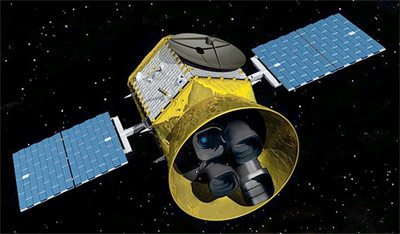update: More information in Phys.org's news item TESS mission to discover new planets moves toward launch, including a video of the telescope array's final assembly.
Also see GSFC's TESS page.
The question: Will there be "Near Space" Ka-band allocations for TESS? is seeking a boolean yes/no plus addressing the item at the end: Are there now approved Near Space Ka-Band frequencies, and does the Wikipedia article need to be updated?
TESS has a group of four wide field cameras each with four large CCD imagers that will collect photometric data at a relatively high cadence, and therefore generate a ton of data.
above: "TESS (Astro-EX 1) [MIT]" From Gunter's Space Page.
Tess will pass near the earth twice a month for a nominal 4 hour 100 Mbit/sec sicence download:
According to TESS (Transiting Exoplanet Survey Satellite)
Table 1: Overview of spacecraft parameters:
[...]
RF communications: Ka-band 100 Mbit/s science downlink
The article goes on to say:
DHU (Data Handling Unit): The DHU is a Space Micro Image Processing Computer (IPC-7000) which consists of six boards: an IPC (Image Processing Computer), which contains two Virtex-7 FPGAs (Field Programmable Gate Arrays) that serve as interfaces to the four cameras and perform high-speed data processing; a Proton 400 k single board computer, which is responsible for commanding, communicating with the spacecraft master avionics unit, and interfacing with the Ka-band transmitter; two 192 GB SSB (Solid-State Buffer) cards for mass data storage; an analog I/O power switch board to control instrument power; and a power supply board for the DHU.
The CCDs (Charge Coupled Devices) produce a continuous stream of images with an exposure time of 2 seconds. These are received by the FPGAs on the IPC, and summed into consecutive groups of 60, giving an effective exposure time of 2 minutes. During science operations, the DHU performs real-time processing of data from the four cameras, converting CCD images into the data products required for ground post-processing. A primary data product is a collection of subarrays (nominally 10 x 10 pixels) centered on preselected target stars. The Proton400 k extracts these subarrays from each 2 min summed image, compresses them and stores them in the SSB prior to encapsulation as CCSDS packets for the Ka-band transmitter. Full frame images are also stacked every 30 minutes and stored in the SSB. Data from the SSB are downlinked every 13.7 days at perigee.
At perigee, science operations are interrupted for no more than 16 hours to point TESS 's antenna toward Earth, downlink data, and resume observing. This includes a nominal 4 hr period for Ka-band science data downlink using NASA's DSN (Deep Space Network). In addition, momentum unloading is occasionally needed due to the ~1.5 N m of angular momentum build-up induced by solar radiation pressure. For this purpose TESS uses its hydrazine thrusters.
The use of the higher frequency Ka band rather than X band or Ku band allows for a combination of higher speed and/or lower power and/or smaller high gain antenna dish diameter.
Here are some rounded numbers from those links:
band frequency wavelength
---- --------- ----------
X 8-12 GHz 37-25 mm
Ku 12-18 GHz 25-17 mm
Ka 27-40 GHz 11-7.5 mm
According to Wikipedia's article Deep Space Bands, deep space is defined by the ITU as greater than 2,000,000 km from the Earth's surface. This excludes anything to do with the Moon's orbit and excludes the Sun-Earth L1 and L2 Lagrange points as well. It therefore excludes TESS' Earth orbit with its period of only 13.7 days.
In the Wikipedia article, there are no entries for Ka-band approved frequencies for near space; there is an asterisk which indicates No assignment or not supported by the DSN. And yet TESS will use the Deep Space Network to download its data - not TDRS.
Are there now approved Near Space Ka-Band frequencies, and does the Wikipedia article need to be updated?
above: "TESS’s never-before-used P/2 orbit." Image: GSFC/NASA. From Extreme Tech's NASA’s TESS mission on track to start hunting exoplanets in 2017. TESS' final orbit is the wider of the two complete ellipses (red) with periapsis near LEO and apoapsis near but less than the Moon's orbit. The period is 13.7 days, or half of the Moon's and phased such that the Moon will be leading or lagging by 90 degrees whenever TESS reaches apoapsis, in order to cancel the strongest of the perturbations from the Lunar gravity and give the orbit a stability lifetime of decades.



